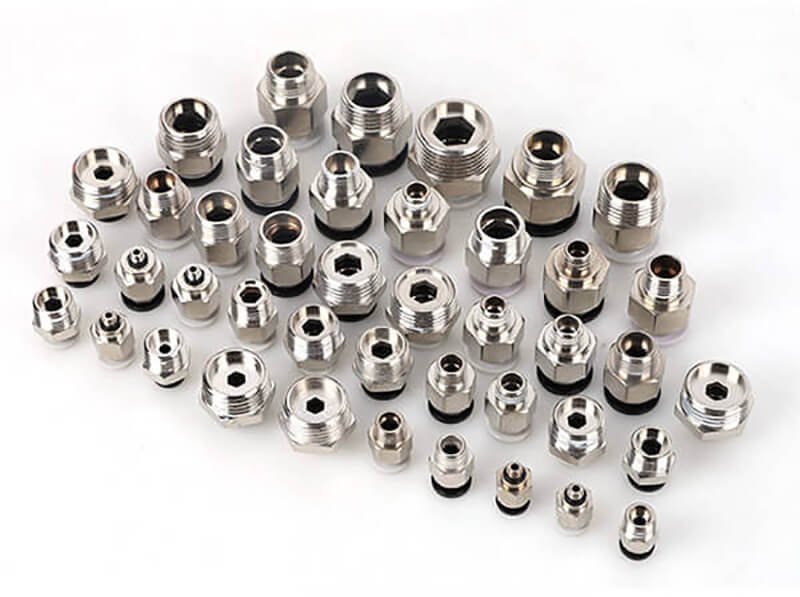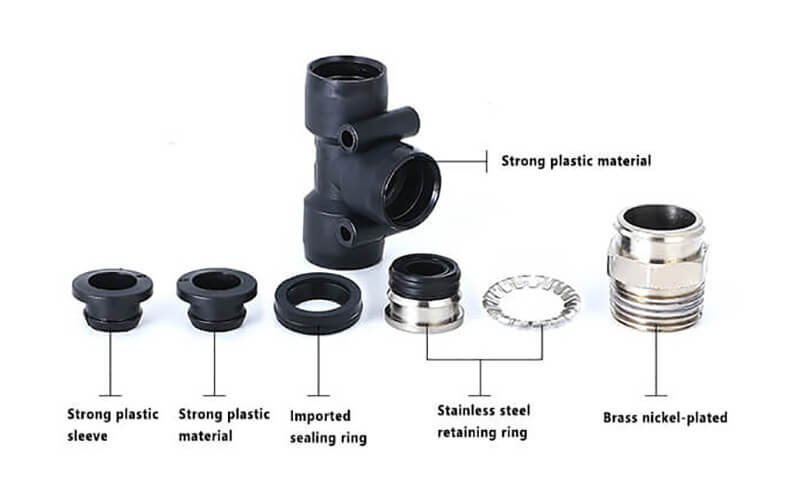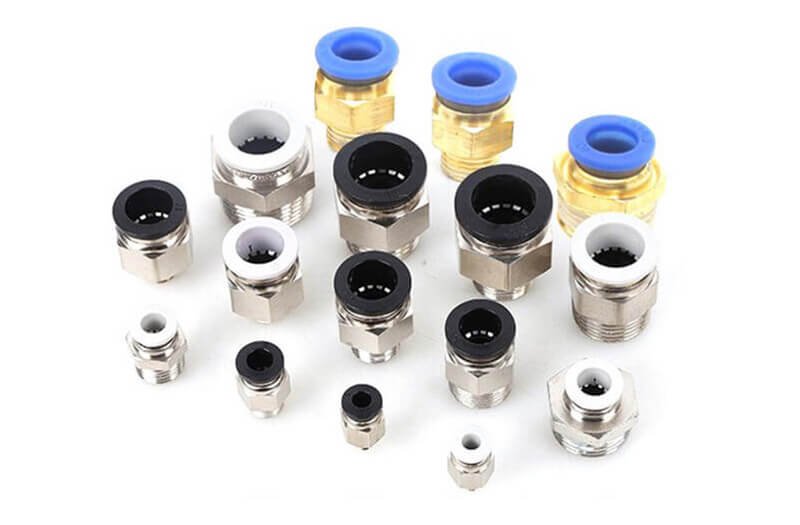When working with pneumatic systems, one of the most important decisions to make is choosing the right material for pneumatic fittings. These fittings play a crucial role in connecting and sealing air lines, ensuring the smooth operation of systems in various industries. The material of the fitting can significantly impact the performance, durability, and safety of the pneumatic system.
In this article, we will explore the most commonly used materials in pneumatic fittings, their advantages and disadvantages, and how to make the best material choice for different applications.

Common Materials Used in Pneumatic Fittings
When selecting pneumatic fittings, understanding the materials used is crucial for ensuring that the system operates effectively and efficiently. The material of a fitting affects its strength, durability, and resistance to various environmental factors such as pressure, temperature, and corrosion. Here are the most commonly used materials in pneumatic fittings:
Brass
Brass is one of the most widely used materials for pneumatic fittings. It is known for its strength, corrosion resistance, and ease of machining. Brass fittings are often used in applications where moderate pressure and temperature are involved.
- Advantages:
- Cost-effective and durable.
- Resistant to corrosion, making it ideal for a variety of environments.
- Offers a good balance between performance and price.
- Common Applications:
- Often used in residential and light industrial systems.
- Perfect for compressed air systems and vacuum lines.
Stainless Steel
Stainless steel is renowned for its high strength, corrosion resistance, and ability to withstand extreme temperatures. It is often chosen for high-pressure systems or harsh environments, such as those found in the oil and gas industry.
- Advantages:
- Excellent resistance to corrosion (even in harsh chemicals and high humidity).
- Handles high pressures and temperatures well.
- Long-lasting and resistant to wear and tear.
- Common Applications:
- Used in heavy-duty industrial systems.
- Ideal for applications in industries such as pharmaceutical, food processing, and automotive.
Aluminum
Aluminum is another popular material, mainly due to its lightweight nature and resistance to corrosion. It is often used in applications where weight reduction is important, such as in aircraft or automotive pneumatic systems.
- Advantages:
- Lightweight and easy to handle.
- Resistant to corrosion, especially in moist environments.
- Cost-effective compared to other metals like stainless steel.
- Common Applications:
- Perfect for low-pressure systems.
- Frequently used in automotive and light-duty industrial applications.
Plastic (e.g., Nylon, Acetal)
Plastic materials such as nylon and acetal are lightweight, flexible, and resistant to corrosion. They are generally used in low-pressure and less demanding applications. Plastic fittings are often chosen for their cost-effectiveness and the ease with which they can be molded into various shapes.
- Advantages:
- Lightweight and easy to install.
- Corrosion-resistant, ideal for low-pressure systems.
- Cost-effective, especially in large quantities.
- Common Applications:
- Often found in office equipment, laboratory settings, and small-scale pneumatic systems.
Other Materials (Copper, Bronze)
Although less common, copper and bronze are sometimes used for specific pneumatic fitting applications. These materials offer good corrosion resistance and are used when higher conductivity or specific chemical resistance is required.
- Advantages:
- Copper is highly resistant to corrosion and excellent for conductivity.
- Bronze provides excellent resistance to wear and is often used in heavy-duty applications.
- Common Applications:
- Primarily used in specialized industries where chemical resistance or electrical conductivity is critical.
Each of these materials offers unique benefits, making them suitable for different environments and applications. The choice of material depends on various factors such as cost, strength, and environmental conditions. In the next section, we’ll dive deeper into how these materials perform under specific conditions and how to select the right one for your needs.
Factors Affecting Material Selection
Choosing the right material for pneumatic fittings isn’t just about picking the most affordable option. Several factors come into play, each influencing how well the material will perform in a specific application. Let’s explore the key factors that should guide your material selection.
Pressure Requirements
One of the most important considerations when selecting a material is the pressure the pneumatic fitting will need to withstand. Materials like stainless steel are well-suited for high-pressure systems due to their strength and durability, while brass and plastic may be sufficient for moderate or low-pressure applications.
- High-pressure applications: Materials like stainless steel and brass are ideal.
- Low-pressure applications: Plastic and aluminum can be suitable choices.
Temperature Resistance
Pneumatic systems can experience varying temperatures, depending on the environment or the application. Materials that are resistant to high or low temperatures ensure that the fitting will not fail due to thermal stress.
- Extreme temperatures: Materials such as stainless steel can withstand high heat without degradation.
- Low temperatures: Some plastics and aluminum perform well in cold environments but may lose strength in extreme heat.
Corrosion Resistance
Corrosion is a significant concern, especially in industries where fittings are exposed to moisture, chemicals, or harsh environments. Choosing a material that resists corrosion can extend the lifespan of the fitting and prevent leaks or failures.
- Corrosion-resistant materials: Stainless steel, brass, and aluminum are known for their ability to withstand corrosion.
- Less resistant materials: Plastic fittings are generally corrosion-resistant, but certain chemicals may still cause degradation.
Cost Considerations
While high-performance materials such as stainless steel and brass offer significant benefits, they are also more expensive. For non-critical applications, plastic or aluminum may provide a more cost-effective solution.
- Budget-conscious projects: Plastic and aluminum are ideal for low-cost systems.
- High-end systems: Materials like stainless steel are best for applications where performance and durability are top priorities.

Advantages and Disadvantages of Each Material
Each material has its own unique set of benefits and drawbacks. Understanding these pros and cons will help you choose the right material based on your specific needs.
Brass
- Advantages:
- Cost-effective and widely available.
- Corrosion-resistant, making it a good option for most applications.
- Durable and capable of handling moderate pressures.
- Disadvantages:
- Not as resistant to high temperatures as stainless steel.
- Can be prone to degradation in certain aggressive chemical environments.
Stainless Steel
- Advantages:
- Offers excellent strength and corrosion resistance.
- Can handle high pressures and extreme temperatures.
- Suitable for use in harsh environments, such as oil and gas or chemical industries.
- Disadvantages:
- Expensive compared to other materials like brass or plastic.
- Can be difficult to machine or install due to its hardness.
Aluminum
- Advantages:
- Lightweight, which makes it ideal for applications where weight reduction is important.
- Corrosion-resistant, especially in moist environments.
- Less expensive than stainless steel, making it suitable for cost-conscious projects.
- Disadvantages:
- Weaker than materials like stainless steel and brass, making it unsuitable for high-pressure applications.
- Less durable in harsh industrial environments where there are high mechanical stresses.
Plastic (e.g., Nylon, Acetal)
- Advantages:
- Lightweight and easy to install.
- Corrosion-resistant, especially in mild environments.
- Cost-effective, making it ideal for budget-friendly projects.
- Disadvantages:
- Limited strength compared to metals like stainless steel.
- Can be affected by UV exposure or chemical exposure, limiting its use in certain environments.
- Temperature limitations—plastics may lose integrity at high temperatures.
Other Materials (Copper, Bronze)
- Advantages:
- Copper is highly resistant to corrosion and excellent for conductivity.
- Bronze offers durability and is resistant to wear and tear.
- Disadvantages:
- Copper fittings are generally more expensive and are not suitable for high-pressure applications.
- Bronze may be overkill for certain low-demand pneumatic systems.

Industry-Specific Material Choices
Different industries have unique requirements for pneumatic systems, and the material selection for pneumatic fittings must align with these specific needs. Let’s explore how material choices vary across some common industries.
Food and Beverage Industry
In the food and beverage industry, hygiene and corrosion resistance are top priorities. Fittings in this sector are often exposed to water, steam, and chemicals used for cleaning, making material selection critical.
- Preferred materials: Stainless steel is the material of choice due to its high resistance to corrosion and ease of cleaning. It is also non-reactive, making it ideal for environments where food safety is paramount.
- Key considerations: Non-toxic, easy-to-clean surfaces, and the ability to withstand harsh cleaning chemicals.
Automotive Industry
In the automotive industry, pneumatic systems are used for various functions, from assembly line automation to air-powered tools. The primary concern here is weight and durability.
- Preferred materials: Aluminum is commonly used for its lightweight properties, reducing the overall weight of the system. Stainless steel may also be used in higher-pressure systems due to its strength and corrosion resistance.
- Key considerations: Low weight, cost-effectiveness, and the ability to withstand vibrations and extreme temperatures.
Oil and Gas Industry
In the oil and gas sector, fittings must endure extreme pressures, temperatures, and corrosive environments such as exposure to chemicals and salty air in offshore applications.
- Preferred materials: Stainless steel is the dominant material due to its high strength, resistance to corrosion, and ability to handle high-pressure systems. Brass may be used for lighter-duty applications.
- Key considerations: High-pressure handling, corrosion resistance, and the ability to withstand harsh environmental conditions.
Pharmaceutical Industry
In the pharmaceutical industry, pneumatic systems are often used for precise operations in clean rooms and controlled environments. Material selection must meet strict standards for both hygiene and performance.
- Preferred materials: Stainless steel is favored for its non-reactivity, durability, and corrosion resistance. It also complies with FDA regulations for food-grade and pharmaceutical equipment.
- Key considerations: Sanitation, chemical resistance, and compliance with industry standards.
General Industrial Use
In general industrial settings, such as manufacturing and packaging, the material choice depends on the type of system, environmental factors, and cost considerations.
- Preferred materials: Brass and aluminum are commonly used for moderate-pressure applications. For more demanding systems, stainless steel is used.
- Key considerations: Pressure and temperature requirements, cost-effectiveness, and durability.
Conclusion
In conclusion, the selection of the material for pneumatic fittings is a key decision that impacts the performance, durability, and safety of the entire system. Understanding the advantages and limitations of materials like brass, stainless steel, aluminum, and plastic helps ensure that the fittings perform optimally in specific applications.
By considering factors such as pressure, temperature, corrosion resistance, and cost, businesses can choose the right material for their pneumatic systems. Furthermore, understanding industry-specific needs allows for the selection of materials that meet specific environmental conditions and performance standards.
Ultimately, whether you are working in the automotive, oil and gas, or pharmaceutical industries, making informed material choices will ensure the long-term success and reliability of your pneumatic systems.


